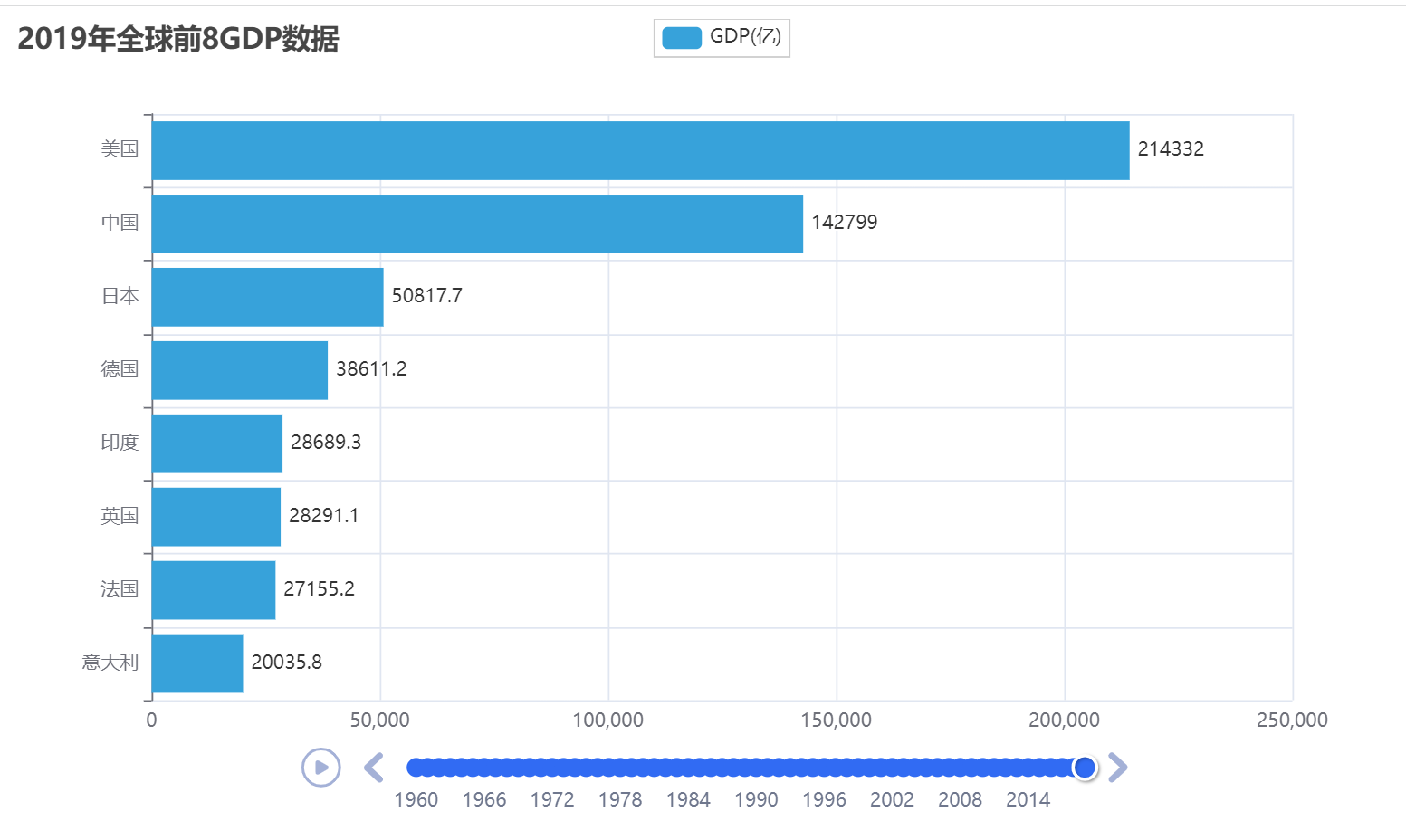Python数据可视化-动态柱状图可视化
一、基础柱状图
通过Bar构建基础柱状图
"""
演示基础柱状图的开发
"""
from pyecharts.charts import Bar
from pyecharts.options import LabelOpts
# 使用Bar构建基础柱状图
bar = Bar()
# 添加x轴的数据
bar.add_xaxis(["中国", "美国", "英国"])
# 添加y轴的数据 label_opts=LabelOpts(position="right")设置数值标签在右侧
bar.add_yaxis("GDP", [30, 20, 10], label_opts=LabelOpts(position="right"))
# 反转x轴和y轴
bar.reversal_axis()
# 绘图
bar.render("基础柱状图.html")
基础柱状图实现效果如下
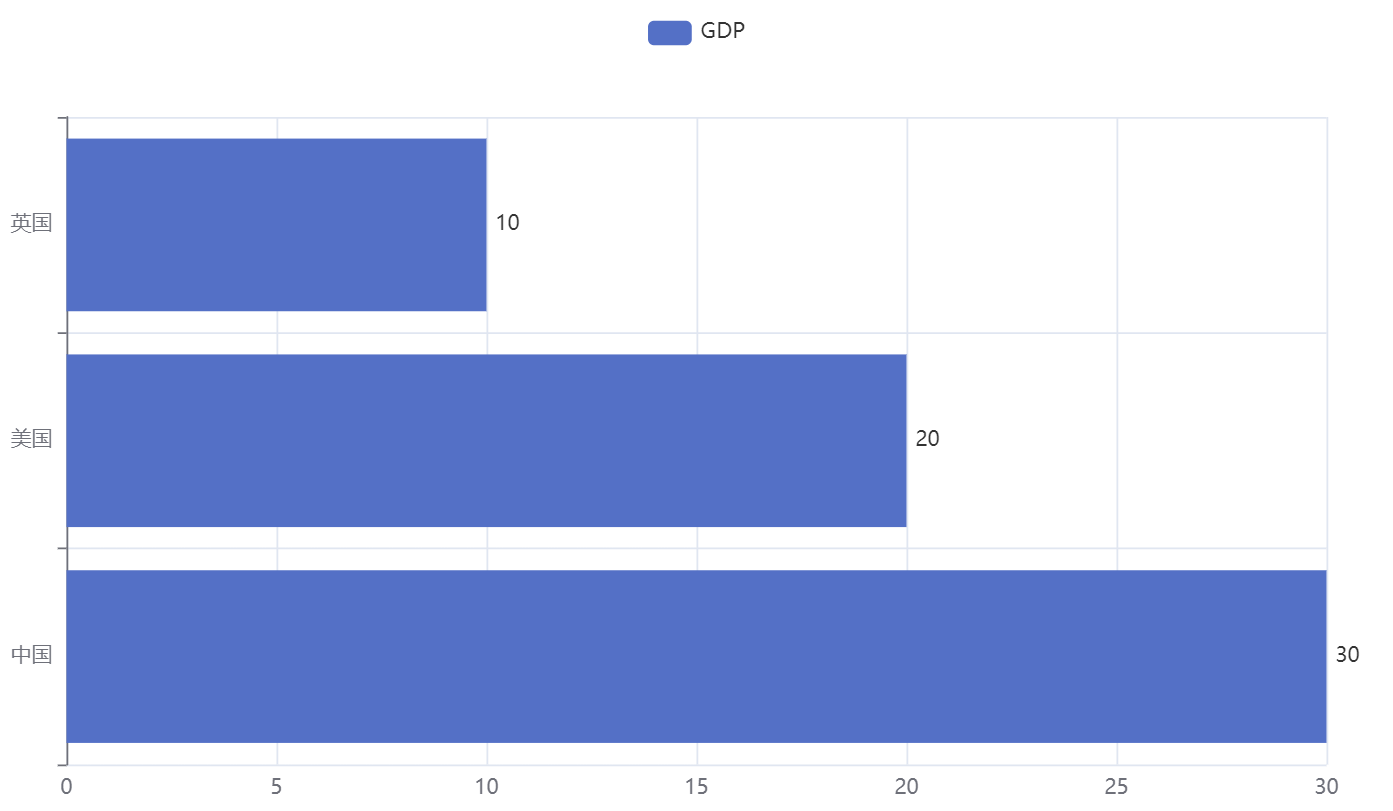
总结
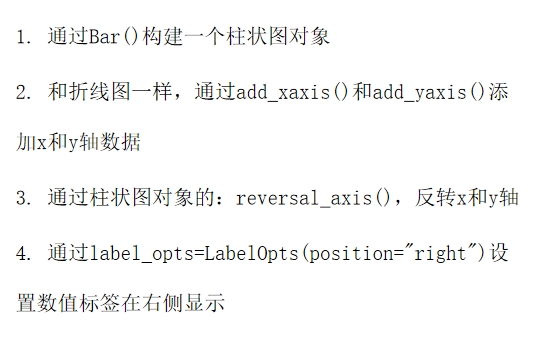
二、基础时间线柱状图
2.1 创建时间线
TimeLine()--时间线
柱状图表述的是分类数据,回答的是每一个分类中【有多少?】这个问题,这是柱状图的主要特点,同时柱状图很难动态的描述一个趋势性的数据,因此pyecharts提供了-时间线
注意:如果说一个Bar、Line对象是一张图表的话,时间线就是创建一个一维的x轴,轴上每一个点就是一个图表对象
from pyecharts.charts import Bar, Timeline
from pyecharts.options import *
from pyecharts.globals import ThemeType
bar1 = Bar()
bar1.add_xaxis(["中国", "美国", "英国"])
bar1.add_yaxis("GDP", [30, 20, 20], label_opts=LabelOpts(position="right"))
bar1.reversal_axis()
bar2 = Bar()
bar2.add_xaxis(["中国", "美国", "英国"])
bar2.add_yaxis("GDP", [50, 40, 30], label_opts=LabelOpts(position="right"))
bar2.reversal_axis()
bar3 = Bar()
bar3.add_xaxis(["中国", "美国", "英国"])
bar3.add_yaxis("GDP", [70, 60, 60], label_opts=LabelOpts(position="right"))
bar3.reversal_axis()
# 创建时间线对象 {"theme": ThemeType.LIGHT}设置时间线主题
timeline = Timeline({"theme": ThemeType.LIGHT})
# timeline对象添加bar柱状图
timeline.add(bar1, "点1")
timeline.add(bar2, "点2")
timeline.add(bar3, "点3")
# 自动播放设置
timeline.add_schema(
play_interval=1000, # 自动播放的时间间隔,单位毫秒
is_timeline_show=True, # 是否在自动播放的时候,显示时间线
is_auto_play=True, # 是否自动播放
is_loop_play=True # 是否循环自动播放
)
# 绘图是用时间线对象绘图,而不是bar对象了
timeline.render("基础时间线柱状图.html")
2.2 总结
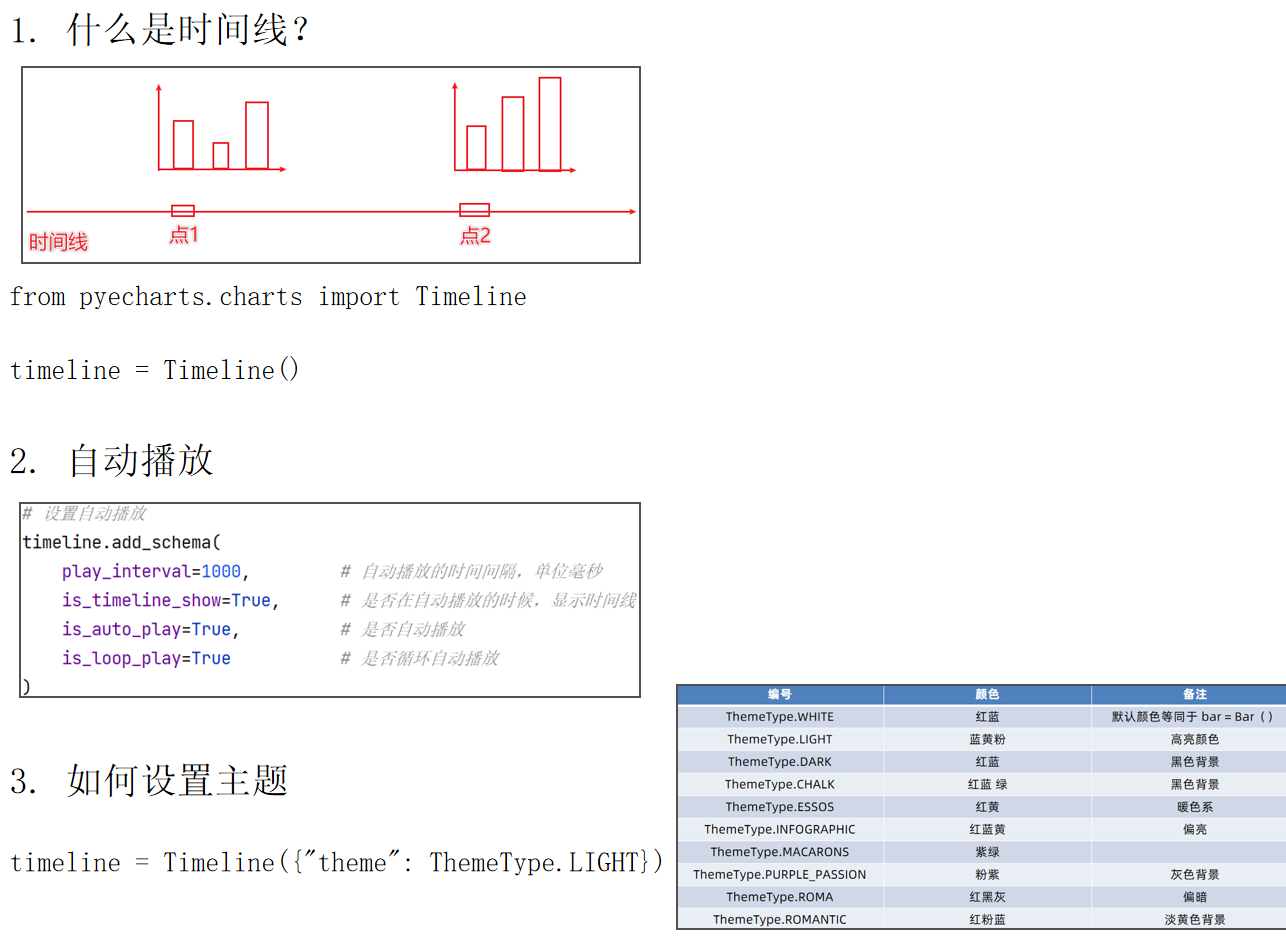
三、GDP动态柱状图绘制
3.1 需求分析
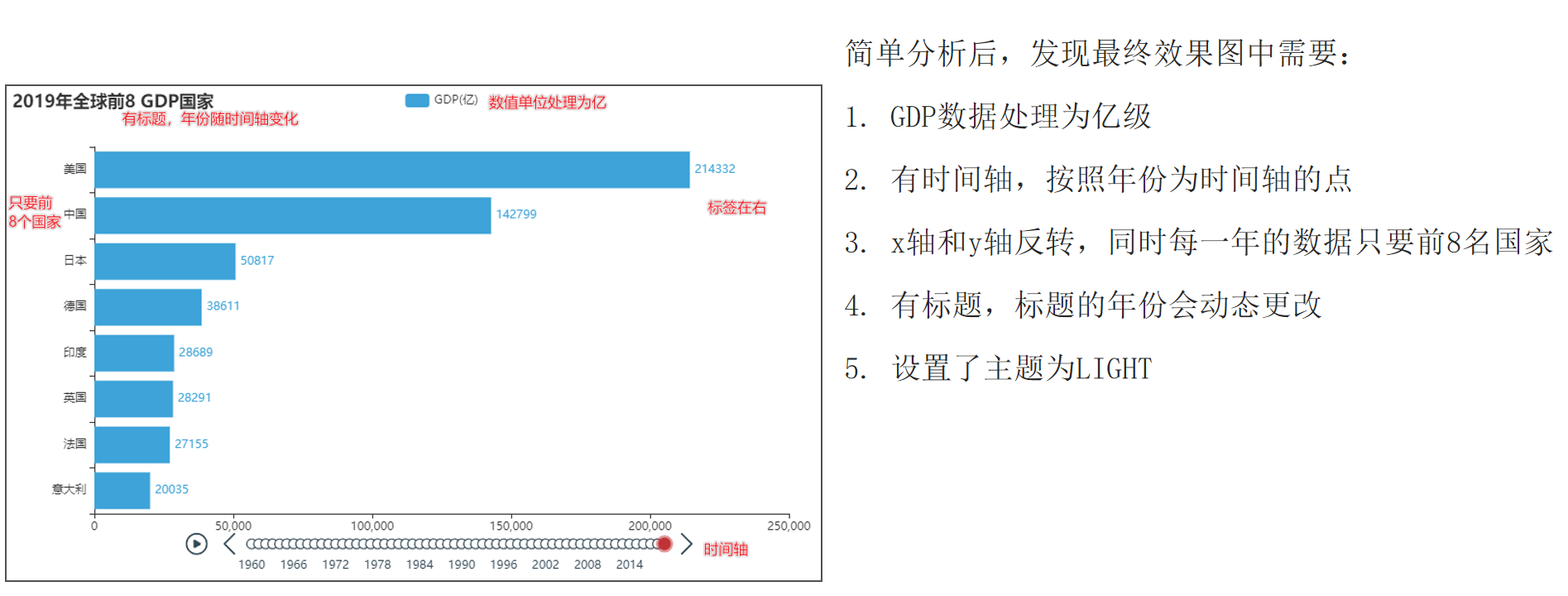
3.2 前置知识--列表的sort方法
使用方式:
列表.sort(key=选择排序依据的函数, reverse=True|False)
- 参数key,是要求传入一个函数,表示将列表的每一个元素都传入函数中,返回排序的数据
- 参数reverse,是否反转排序结果,True表示降序,False表示升序
示例代码:
"""
扩展列表的sort方法
在学习了将函数作为参数传递后,我们可以学习列表的sort方法来对列表进行自定义排序
"""
# 准备列表
my_list = [["a", 33], ["b", 15], ["c", 40]]
# 排序,基于带名函数
def choose_sort_key(element):
return element[1]
# my_list.sort(key=choose_sort_key, reverse=True)
# 排序,基于lambda匿名函数
my_list.sort(key=lambda element: element[1], reverse=True)
print(my_list)
3.3 代码展示
"""
演示第三个图表:GDP动态柱状图开发
"""
from pyecharts.charts import Bar, Timeline
from pyecharts.globals import ThemeType
from pyecharts.options import *
# 读取数据
f = open("1960-2019全球GDP数据.csv", "r", encoding="GBK")
data_lines = f.readlines()
# 关闭文件
f.close()
# 删除第一条数据
data_lines.pop(0)
# 将数据转换为字典存储,格式为:
# { 年份: [ [国家, gdp], [国家,gdp], ...... ], 年份: [ [国家, gdp], [国家,gdp], ...... ], ...... }
# { 1960: [ [美国, 123], [中国,321], ...... ], 1961: [ [美国, 123], [中国,321], ...... ], ...... }
# 先定义一个字典对象
data_dict = {}
for line in data_lines:
year = int(line.split(",")[0]) # 年份
country = line.split(",")[1] # 国家
gdp = float(line.split(",")[2]) # gdp数据
# 如何判断字典里面有没有指定的key呢?
try:
data_dict[year].append([country, gdp])
except KeyError:
data_dict[year] = []
data_dict[year].append([country, gdp])
# 创建时间线对象
timeline = Timeline({"theme": ThemeType.LIGHT})
# 排序年份
sorted_year_list = sorted(data_dict.keys())
for year in sorted_year_list:
data_dict[year].sort(key=lambda element: element[1], reverse=True)
# 取出本年份前8名的国家
year_data = data_dict[year][0:8]
x_data = []
y_data = []
for country_gdp in year_data:
x_data.append(country_gdp[0]) # x轴添加国家
y_data.append(country_gdp[1] / 100000000) # y轴添加GDP数据
# 构建柱状图
bar = Bar()
x_data.reverse()
y_data.reverse()
bar.add_xaxis(x_data)
# label_opts=LabelOpts(position="right"):设置数值标签在右侧
bar.add_yaxis("GDP(亿)", y_data, label_opts=LabelOpts(position="right"))
# 反转x轴和y轴
bar.reversal_axis()
# 设置每一年的图标标题
bar.set_global_opts(
title_opts=TitleOpts(title=f'{year}年全球前8GDP数据')
)
timeline.add(bar, str(year))
# for循环每一年的数据,基于每一年的数据,创建每一年的bar对象
# 在for中,将每一年的bar对象添加到时间线中
timeline.add_schema(
play_interval=1000, # 自动播放的时间间隔,单位毫秒
is_timeline_show=True, # 是否在自动播放的时候,显示时间线
is_auto_play=True, # 是否自动播放
is_loop_play=False # 是否循环自动播放
)
# 绘图
timeline.render("1960-2019全球GDP前8国家.html")
实现效果图:
